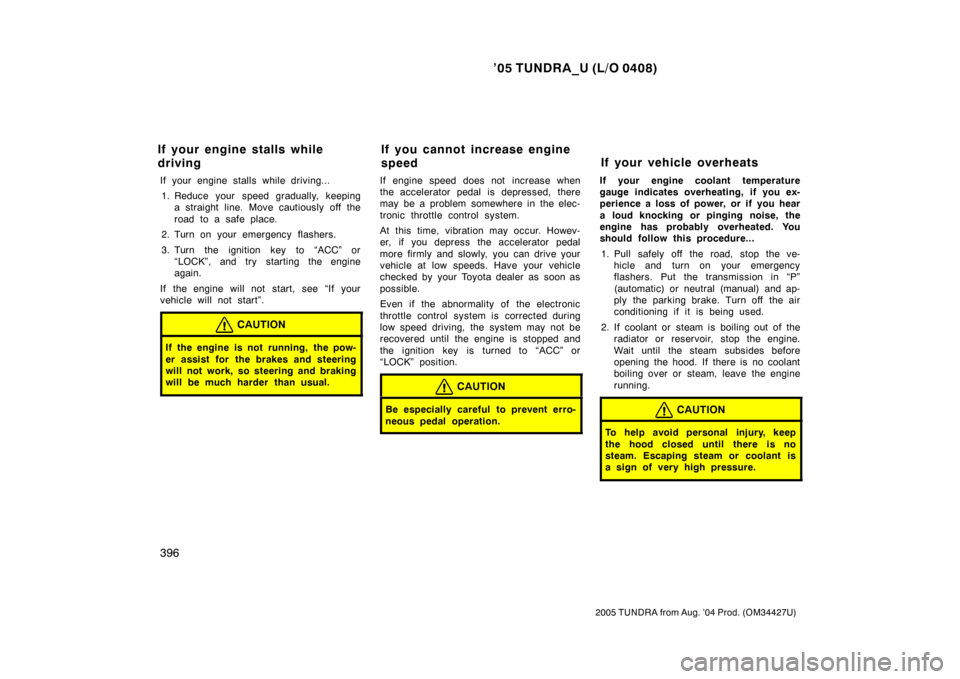Page 402 of 506

’05 TUNDRA_U (L/O 0408)
391
2005 TUNDRA from Aug. ’04 Prod. (OM34427U)
IN CASE OF AN EMERGENCY
In case of an emergency
If your vehicle will not start 392
. . . . . . . . . . . . . . . . . . . . . . . . . . . . . . . . . . .
If your engine stalls while driving 396
. . . . . . . . . . . . . . . . . . . . . . . . . . . . .
If you cannot increase engine speed 396
. . . . . . . . . . . . . . . . . . . . . . . . . .
If your vehicle overheats 396
. . . . . . . . . . . . . . . . . . . . . . . . . . . . . . . . . . . . \
If you have a flat tire 397
. . . . . . . . . . . . . . . . . . . . . . . . . . . . . . . . . . . . \
. . . . .
If your vehicle becomes stuck 409
. . . . . . . . . . . . . . . . . . . . . . . . . . . . . . . .
If your vehicle needs to be towed 410
. . . . . . . . . . . . . . . . . . . . . . . . . . . . .
If you lose your keys 415
. . . . . . . . . . . . . . . . . . . . . . . . . . . . . . . . . . . . \
. . . .
If you lose your wireless remote control transmitter 416
. . . . . . . . . . . . .
SECTION 4
Page 403 of 506

’05 TUNDRA_U (L/O 0408)
392
2005 TUNDRA from Aug. ’04 Prod. (OM34427U)
Before making these checks, make sure
you have followed the correct starting pro-
cedure given in “How to start the engine”
in Section 3 and that you have sufficient
fuel.
If the engine is not turning over or is
turning over too slowly—
1. Check that the battery terminals are tight and clean.
2. If the battery terminals are O.K., switch on the interior light.
3. If the light is out, dim or goes out when the starter is cranked, the battery
is discharged. You may try jump start-
ing. See “(c) Jump starting” for further
instructions.
If the light is O.K., but the engine still will
not start, it needs adjustment or repair.
Call a Toyota dealer or qualified repair
shop.
NOTICE
Do not pull − or push−start the ve-
hicle. Your vehicle may suddenly
move when the engine starts, and
may damage itself or cause a colli-
sion. Also the three −way catalytic
converter may overheat and become a
fire hazard.
If the engine turns over at its normal
speed but will not start—
1. Turn the ignition key to “ACC” or “LOCK” and try starting the engine
again.
2. If the engine will not start, the engine may be flooded because of repeated
cranking. See “(b) Starting a flooded
engine” for further instructions.
3. If the engine still will not start, it needs adjustment or repair. Call a Toyota
dealer or qualified repair shop. If the engine will not start, your engine
may be flooded because of repeated
cranking.
With manual transmission—
If this happens, turn the ignition key to
“START” with the accelerator pedal fully
depressed. Keep the key and accelerator
pedal in these positions for 15 seconds
and release them. Then try starting the
engine with your foot off the accelerator
pedal.
If the engine does not start after 15 se-
conds of cranking, release the key, wait
a few minutes and try again.
If the engine still will not start, it needs
adjustment or repair. Call a Toyota dealer
or qualified repair shop for assistance.
NOTICE
Do not crank for more than 30 se-
conds at a time. This may overheat
the starter and wiring systems.
If your vehicle will not start—
(a) Simple checks
(b) Starting a flooded engine
Page 407 of 506

’05 TUNDRA_U (L/O 0408)
396
2005 TUNDRA from Aug. ’04 Prod. (OM34427U)
If your engine stalls while driving...
1. Reduce your speed gradually, keeping a straight line. Move cautiously off the
road to a safe place.
2. Turn on your emergency flashers.
3. Turn the ignition key to “ACC” or “LOCK”, and try starting the engine
again.
If the engine will not start, see “If your
vehicle will not start”.
CAUTION
If the engine is not running, the pow-
er assist for the brakes and steering
will not work, so steering and braking
will be much harder than usual.
If engine speed does not increase when
the accelerator pedal is depressed, there
may be a problem somewhere in the elec-
tronic throttle control system.
At this time, vibration may occur. Howev-
er, if you depress the accelerator pedal
more firmly and slowly, you can drive your
vehicle at low speeds. Have your vehicle
checked by your Toyota dealer as soon as
possible.
Even if the abnormality of the electronic
throttle control system is corrected during
low speed driving, the system may not be
recovered until the engine is stopped and
the ignition key is turned to “ACC” or
“LOCK” position.
CAUTION
Be especially careful to prevent erro-
neous pedal operation.
If your engine coolant temperature
gauge indicates overheating, if you ex-
perience a loss of power, or if you hear
a loud knocking or pinging noise, the
engine has probably overheated. You
should follow this procedure... 1. Pull safely off the road, stop the ve- hicle and turn on your emergency
flashers. Put the transmission in “P”
(automatic) or neutral (manual) and ap-
ply the parking brake. Turn off the air
conditioning if it is being used.
2. If coolant or steam is boiling out of the radiator or reservoir, stop the engine.
Wait until the steam subsides before
opening the hood. If there is no coolant
boiling over or steam, leave the engine
running.
CAUTION
To help avoid personal injury, keep
the hood closed until there is no
steam. Escaping steam or coolant is
a sign of very high pressure.
If your engine stalls while
driving If you cannot incr
ease engine
speed If your vehicle overheats
Page 503 of 506

’05 TUNDRA_U (L/O 0408)
2005 TUNDRA from Aug. ’04 Prod. (OM34427U)
Publication No. OM34427U
Part No. 01999-34427
Printed in Japan 01-0408-00
(U)
Quick index
�If a service reminder indicator or warning buzzer comes on 170 . . . . . . . . . . .
� If your vehicle will not start 392 . . . . . . . . . . . . . . . . . . . . . . . . . . . . . . . . . . . . .\
. . . .
� If your engine stalls while driving 396 . . . . . . . . . . . . . . . . . . . . . . . . . . . . . . . . . . .
� If your vehicle overheats 396 . . . . . . . . . . . . . . . . . . . . . . . . . . . . . . . . . . . . .\
. . . . . .
� If you have a flat tire 397 . . . . . . . . . . . . . . . . . . . . . . . . . . . . . . . . . . . . .\
. . . . . . . . .
� If your vehicle needs to be towed 410 . . . . . . . . . . . . . . . . . . . . . . . . . . . . . . . . . . .
� Tips for driving during break −in period 341 . . . . . . . . . . . . . . . . . . . . . . . . . . . . . . .
� How to start the engine 372 . . . . . . . . . . . . . . . . . . . . . . . . . . . . . . . . . . . . .\
. . . . . . .
� General maintenance 425 . . . . . . . . . . . . . . . . . . . . . . . . . . . . . . . . . . . . .\
. . . . . . . . .
� Complete index 491 . . . . . . . . . . . . . . . . . . . . . . . . . . . . . . . . . . . . .\
. . . . . . . . . . . . . . .
Gas station information
Fuel type:
1GR −FE engine: UNLEADED gasoline, Octane Rating 87 (Research Octane
Number 91) or higher
For improved vehicle performance, the use of premium unleaded gasoline
with an Octane Rating of 91 (Research Octane Number 96) or higher is
recommended.
2UZ −FE engine: UNLEADED gasoline, Octane Rating 87 (Research Octane
Number 91) or higher
See page 341 for detailed information.
Fuel tank capacity: 100 L (26.4 gal., 22.0 lmp. gal.)
Engine oil:
API grade SL “Energy −Conserving” or ILSAC multigrade engine oil is
recommended.
See page 439 for detailed information.
Tire information: See pages 444 through 452.
Tire inflation pressure: See page 478.
TU�1
B